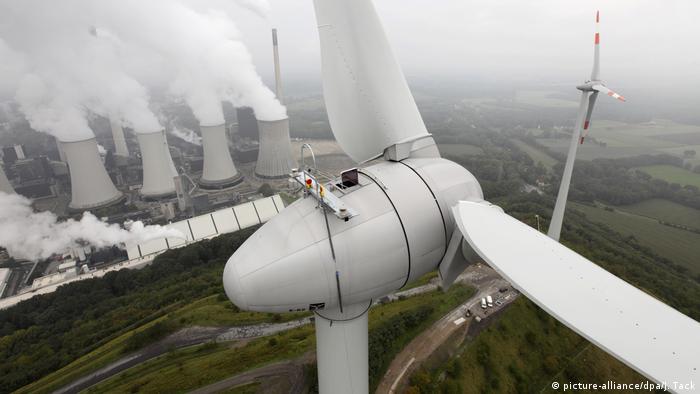Germany intends to become climate-neutral. The big questions is just how much wind and solar power that will require. But it's difficult to figure out how much power the country will actually need in the next decade.

German experts are divided over how much energy from renewables will be needed in the future
Germany intends to do more to protect the environment. Following a ruling by the Constitutional Court in March, the government announced that by 2030 CO2 emissions should be reduced by 65% compared with 1990 levels and not by 55% as originally planned. To reach this goal, more electricity from renewable sources will be needed than previously planned.
The goal sounds challenging, and as usual the devil is in the details. In order to achieve this target, there needs to be more development and expansion of wind and solar power capacities. How much more depends on the estimates for electricity consumption in 2030.
So far, the German Economy Ministry has assumed that electricity consumption will not change significantly over the next nine years and will remain at about 580 terawatt-hours (TWh). A glance back seems to support this.
"In the last 10 or 20 years, electricity consumption has been relatively constant," said Johannes Wagner, from the Institute of Energy Economics (EWI) at the University of Cologne. "We had gross electricity consumption of around 600 terawatt-hours over a long period of time. It only fell sharply in 2020 due to effects from the coronavirus.
Will Germany need more electricity in 2030?
But what was true in the past does not necessarily apply to the future. Various experts assume that the government's planning is too cautious. Social Democrat chancellor candidate Olaf Scholz criticized it recently. "Anyone who claims that electricity consumption will remain the same until 2030 is lying to themselves and the country," he said.
What if energy consumption doesn't stay the same? What if it increases? What if it increases sharply? This is the scenario that various energy experts assume will happen.
"The expert commission for monitoring the energy transition, to which I belong, has estimated electricity consumption will be significantly higher than the government believes," Veronika Grimm told DW. "We come in at around 650 terawatt-hours and are thus still at the lower end of the spectrum," she said.
Agora Energiewende, a think tank specializing in energy, also mentions 650 terawatt-hours of electricity consumption in 2030. EWI in Cologne estimates that 685 terawatt-hours will be needed then.
The Germany Renewable Energy Federation (BEE) figures that it will be 745 terawatt-hours and the Fraunhofer Institute for Solar Energy Systems (ISE) anticipates electricity consumption of 780 terawatt-hours in 2030. That is 70 to 200 terawatt-hours more than the government forecasts.
Mobility concepts require lots of electricity
According to the experts, more electricity will be needed mainly because of the move to e-mobility and the fact that buildings will be heated differently. At the same time manufacturers will turn away from fossil fuels and switch to synthetic energy sources like hydrogen. But the production of green hydrogen also requires electricity.
On the other hand, there are efficiency gains that reduce electricity consumption. Here the government has set the goal of reducing electricity consumption by 25% by 2050 compared with 2008 levels through greater energy efficiency.
These efficiency gains cannot compensate for the additional electricity demand, experts say. In addition, large efficiency potentials have not yet been systematically used, although such technologies are already available, according to research by Agora Energiewende.

New above-ground power lines have not gone down well with many locals across Germany
Being energy-efficient isn't enough
How many new wind turbines and photovoltaic installations Germany needs will depend on how its hunger for electricity develops. Using the relatively low 2030 estimate by Agora Energiewende, each year Germany would have to add around 10 gigawatts of solar power, 1.7 gigawatts of wind on land and four to five gigawatts of wind power at sea.
"That is roughly comparable to what we had in recent years, in the record expansion years," said Mara Kleiner, from Agora Energiewende. "So it's doable."
The current growth in both photovoltaics and wind energy is below these highs. So there needs to be more momentum, according to Kleiner.
Grimm also said it would be challenging to significantly accelerate the expansion of renewable energies. Especially when it comes to onshore wind energy, there are always protests from local residents.
"That is why we have to concentrate even more on offshore expansion," Grimm said. But not even that is without problems, since new power lines would have to be built across Germany — something else that often meets with resistance.
It can only work in collaboration
And this probably won't work alone either. "Germany currently exports electricity abroad," pointed out EWI's Wagner. "In the medium term, we can expect that Germany will become a net importer for the first time."
Manufacturing is one example. Here Grimm believes that it will not be possible to ramp up the production of green hydrogen quickly enough. "We have to prepare for importing green hydrogen at the same time," she said. There are already various projects with Morocco, Chile, Australia and EU countries. In addition, blue hydrogen must also be used during a transitional phase. Blue hydrogen is hydrogen that is produced from natural gas where CO2 emissions are captured and stored.
But, first of all, the German government will have to recalculate the country's future electricity requirements. Now even Chancellor Angela Merkel considers the previous assumptions that the demand for electricity will not increase to be "probably not future-proof."
It is expected that the European Union will come up with some new regulations on climate protection in July. Then, all EU countries will have to adapt their own measures to comply with rules that may be a lot tougher than before.
This article was adapted from the original German.
How many new wind turbines and photovoltaic installations Germany needs will depend on how its hunger for electricity develops. Using the relatively low 2030 estimate by Agora Energiewende, each year Germany would have to add around 10 gigawatts of solar power, 1.7 gigawatts of wind on land and four to five gigawatts of wind power at sea.
"That is roughly comparable to what we had in recent years, in the record expansion years," said Mara Kleiner, from Agora Energiewende. "So it's doable."
The current growth in both photovoltaics and wind energy is below these highs. So there needs to be more momentum, according to Kleiner.
Grimm also said it would be challenging to significantly accelerate the expansion of renewable energies. Especially when it comes to onshore wind energy, there are always protests from local residents.
"That is why we have to concentrate even more on offshore expansion," Grimm said. But not even that is without problems, since new power lines would have to be built across Germany — something else that often meets with resistance.
It can only work in collaboration
And this probably won't work alone either. "Germany currently exports electricity abroad," pointed out EWI's Wagner. "In the medium term, we can expect that Germany will become a net importer for the first time."
Manufacturing is one example. Here Grimm believes that it will not be possible to ramp up the production of green hydrogen quickly enough. "We have to prepare for importing green hydrogen at the same time," she said. There are already various projects with Morocco, Chile, Australia and EU countries. In addition, blue hydrogen must also be used during a transitional phase. Blue hydrogen is hydrogen that is produced from natural gas where CO2 emissions are captured and stored.
But, first of all, the German government will have to recalculate the country's future electricity requirements. Now even Chancellor Angela Merkel considers the previous assumptions that the demand for electricity will not increase to be "probably not future-proof."
It is expected that the European Union will come up with some new regulations on climate protection in July. Then, all EU countries will have to adapt their own measures to comply with rules that may be a lot tougher than before.
This article was adapted from the original German.
No comments:
Post a Comment